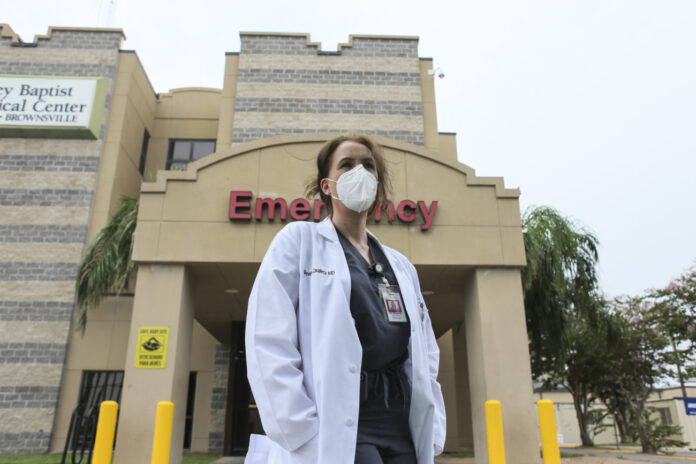
BROWNSVILLE — What Dr. Beverly Zavaleta encounters in her job on a daily basis should be enough to convince even the most nonchalant among us not to roll the dice on COVID-19.
As the number of cases and deaths continues to surge in Brownsville, the hospitalist and physician adviser for Valley Baptist Medical Center Brownsville told The Brownsville Herald that, while many patients recover and return home, many do not. Older COVID-19 patients who have to intubated — placed on a ventilator— are the least likely to survive, she said.
“Always the older patients fare worse, especially when we look at the deaths,” Zavaleta said.
While different studies have come to different conclusions about the percentage of mortality for intubated virus patients, statistics on Cameron County deaths related to the virus show that patients 80 or older “have a very slim change of surviving,” she said.
“So our grandparents are dying,” Zavaleta said. “They’re dying. Could one in 10 survive? Yes. But for the most part they’re not making it. They’re not.”
Jamil M. Madi, a critical care physician for VBMC, posted on social media recently that the “large majority” of COVID-19 patients who are intubated die. He noted that patients ventilated for 10 to 14 days (sometimes less) and who can’t be weaned suffer stiffened lungs and irreversible lung damage, and invariably die.
“It’s a devastating disease,” he wrote. “We have all been practicing pulmonary and critical care for decades and we have never encountered something as virulent and desolating on a mass scale as this. Protect your vulnerable ones and the elderly please.”
It’s not just elderly patients being placed on ventilators. Zavaleta said VBMC Brownsville has several patients in their 20s, 30s and 40s who have had to be intubated. While it’s true that younger COVID-19 patients have a better chance of surviving intubation, there’s little consolation there, she said.
“Hearing (that) if you’re 20 you’ve got a 50/50 chance, is that really good news? To me, when I hold the hand of a 42-year-old, and I’m helping them talk to their children before they’re intubated, because that might be good bye, I’m sorry, that is not good news,” Zavaleta said. “That is something that haunts me at night when I go to sleep. Yeah, I’m going to fight for that person, of course. We all are, as a team.”
A recent Emory University study concluded that the survival rate of intubated COVID-19 patients is 70 percent, though Zavaleta suspects that figure is optimistic. At any rate, even if “only” 30 percent of ventilated patients die, that’s a grim statistic, she said.
“I don’t think that’s a reason why we need to go out to South Padre Island and have massive parties,” Zavaleta said. “I don’t want to put 40-year-olds on a ventilator. I don’t want to do that. What we want the community to understand is that we have to prevent transmission. We have got to put in place measures to prevent transmission, which means wearing a mask in public at all times, keeping six feet of physical distance in public, avoiding large gatherings.”

While some people might see no harm in “getting together with a few friends for a barbecue,” they’re actually inviting all the germs of all the other dozens of people those “few friends” have been in contact with, she said. Community transmission, in fact, is the biggest cause of virus spread in Cameron County during the current surge.
“You really can’t do that right now,” Zavaleta said. “We can’t.”
Watching the news and keeping track of COVID-19 developments on social media — perhaps a little too much, she admitted — Zavaleta said she’s seeing plenty of “anger, blame and shame” in people’s reaction to the pandemic. While it may be hard not to react that way, it won’t “provide us a way forward,” she said.
“I think we must take a path of compassion and generosity and caring and love and patience,” Zavaleta said. “We have to do that. That is the only way that we are going to save each other. And that is very difficult, but I do believe we can do it. I am trying to keep my message focused on that, and focused on bringing those qualities in myself to everybody as best I can and as best I know how.”





